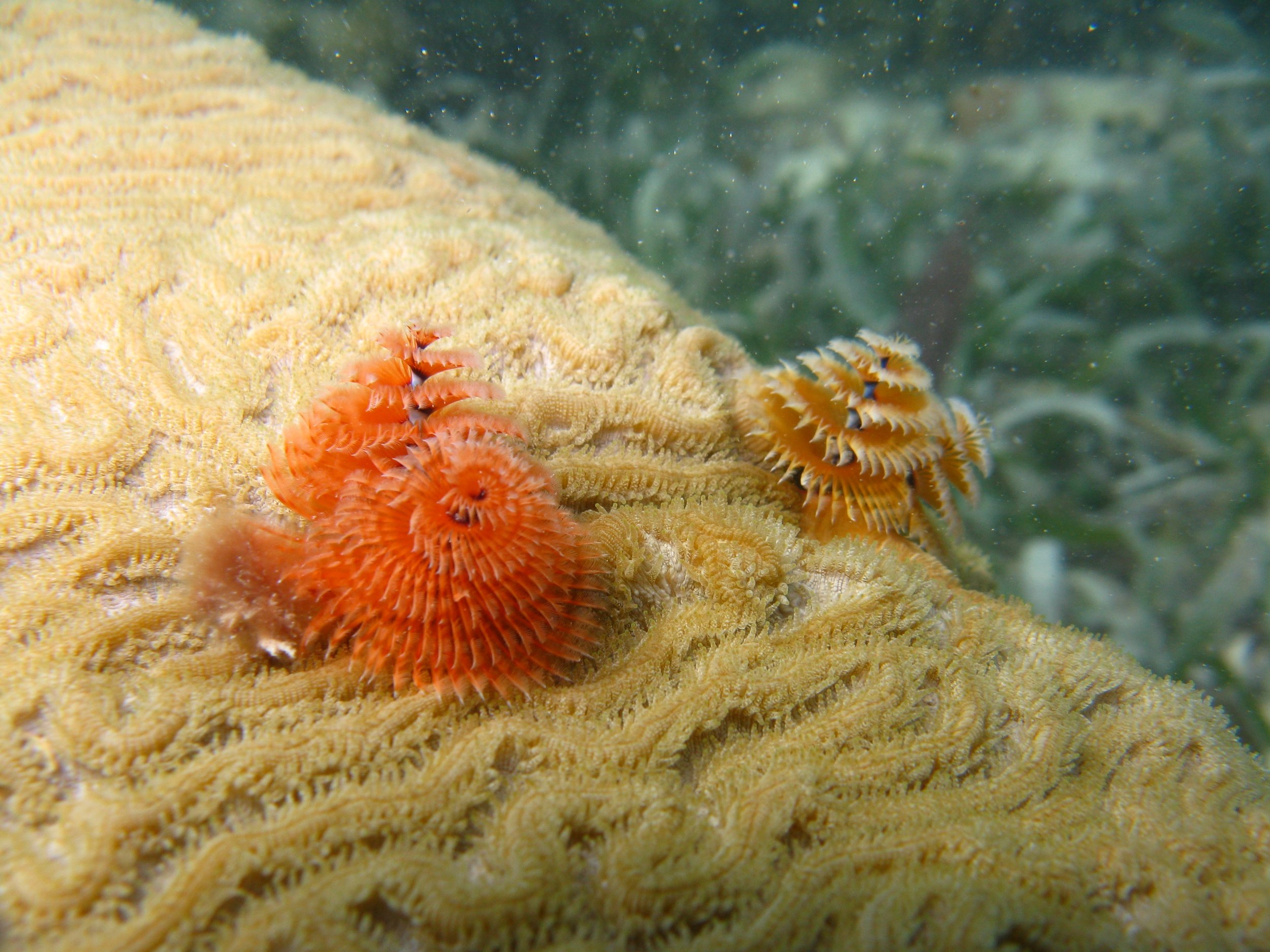You’ve Heard of Elf on the Shelf, But Have You Heard Of…
By Molly Ripka
…Christmas Trees in the Sea
These worms resemble tiny trees decorating our reefs!
Tiny worms form tubes in coral heads to make their homes, but their namesake comes from their appearance in the water. The Christmas tree worms have feeding appendages called radioles which rival the colors of any well-decorated tree! These radioles are used for respiration and for catching dinner in the water column.
Unlike their pine counterparts, Christmas tree worms are able to pull their radioles underground, and cover their tube homes with a hard operculum that protects them from predators. If you get too close to one, it will quickly retreat, so approach slowly if you want to get a good look.
…Candy Canes under the Waves
Looking good enough to eat! Our coral banded shrimp might look a little too much like a candy cane this time of year…
The most widely-distributed shrimp in the sea, the coral banded shrimp has red and white stripes that remind us of striped candy canes. This little critter usually hangs upside-down in caves or under rocks, and can sometimes be hard to spot.
Coral banded shrimp have fairly long front claws, and a second, smaller set used for more fine-tuned grasping. But if you are searching for one of these three-inch crustaceans, you’re likely to see the white antennae first. They sometimes hang out in pairs, which usually indicates that they are a mated pair.
…Lights in the Bight
Our squid will be winning some holiday costume contests this year, as they can change color.
With reflective skin that is certainly bright enough to help celebrate the Hanukkah Festival of Lights, the Caribbean reef squid is one of those rare mollusks that you can find in the shallow waters of the coral reef and near rocky shores. To make their appearance even more fantastic, the reef squid have chromatophores in their skin, which are specialized cells that help the squid change color. Varying pigments of red, yellow, and brown can be expanded in their skin. But why then do they sometimes look blue, or green? The answer lies in another specialized skin cell called iridophores, which reflect different wavelengths of light at different angles.
Caribbean reef squid are also well-known for their defensive inking behavior. When startled, squid can release a jet of ink that is either cloudy and blocks out their escape, or is thick and viscous and may confuse a predator into going for the ink instead of the squid itself. These invertebrates generally school together, and sometimes can look like the candles in the menorah if you squint hard enough!
…Cucumbers in Slumber
Our sea cucumber might not look like something you’d want to see in your salad, but they serve an important role in our reef ecosystem.
‘Twas the night before Christmas, and all through the house,
Not a creature was stirring, not even a…cucumber?
Sea cucumbers are slow-moving, innocuous creatures, but they provide a key service to our coral reef ecosystems. Those that feed using their sticky face tentacles (a fun adaptation to picture) pick up food on the ground as well as sand particles. After digesting the food, the sand passes through cleaner than it was when it went in. Sea cucumbers are the janitors of the sea!
Some sea cucumbers have face tentacles that filter suspended particles from the water column. Cucumbers also have a unique adaptation called evisceration where if they feel threatened, they will expel their internal organs! This can scare off predators, or leave the predator to feast on the entrails while the cucumber makes a slow and steady escape. But don’t worry; sea cucumbers can regrow their insides and live to see another day!
…Spines in the Brine
We wouldn’t want to cuddle with these critters anytime soon, but we still love how they keep our reef ecosystem balanced!
Want more of a spine-chilling holiday season? Longspine sea urchins may look like something out of Krampus’ sack, but they are important for the biological balance of our coral reefs. When 99% of their population died within a year due to a pathogen in 1983, the reefs started to grow too much algae that smothered many corals. Since the population of the urchins has grown back, they’ve eaten most of that algae away and the reef is back in balance.
Longspine urchins have long, hollow spines that are mildly venomous. This is to deter predators that may try to eat them. Unwary humans are sometimes stung, usually while walking in tide pools (wear shoes, people!) or while cleaning an aquarium housing one of these urchins. However, the venom is generally mild, and aquarists can safely hold the longspine urchins if they are gentle with the spiky creatures.
…Night Stars on a Sandbar
During the day, our star coral tucks in its tentacles and lets the photosynthetic algae sharing its cells do most of the work.
There are stars that come out at night, and no, they’re not in the sky! Star coral are a relatively hardy species, and they live at the reef as well as closer to shore. Their tiny polyps are closed during the day while they photosynthesize, and their tentacles emerge at night to feed on plankton drifting by.
Star coral are one of the most common coral fossils found in the Florida Keys. The limestone of the Keys was made from ancient coral reefs, and almost any large rock you see may harbor a fossil. If you are on a tide pool, look for the characteristic circles with sunflower-shaped septa inside. Stony coral such as star coral are literally and figuratively the base of our island chain. They formed the land beneath our feet, and they support the ecosystem that drives our tourism and fishing industries.






